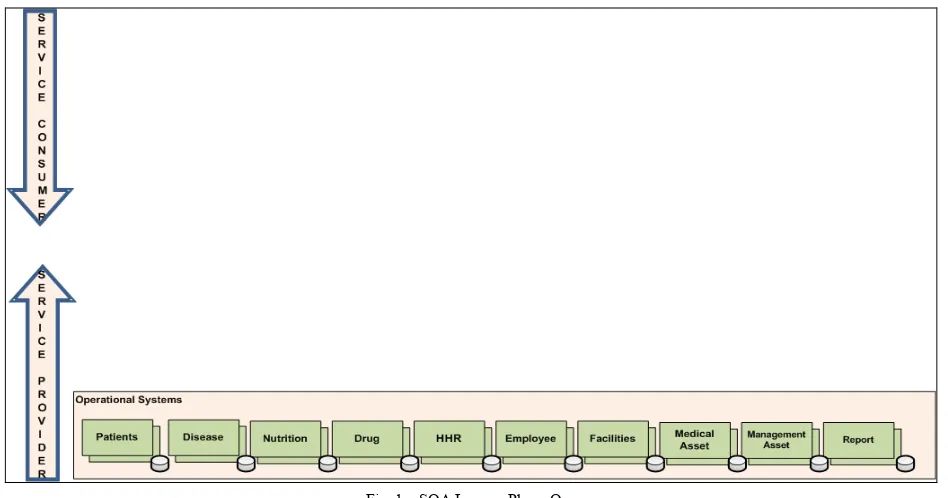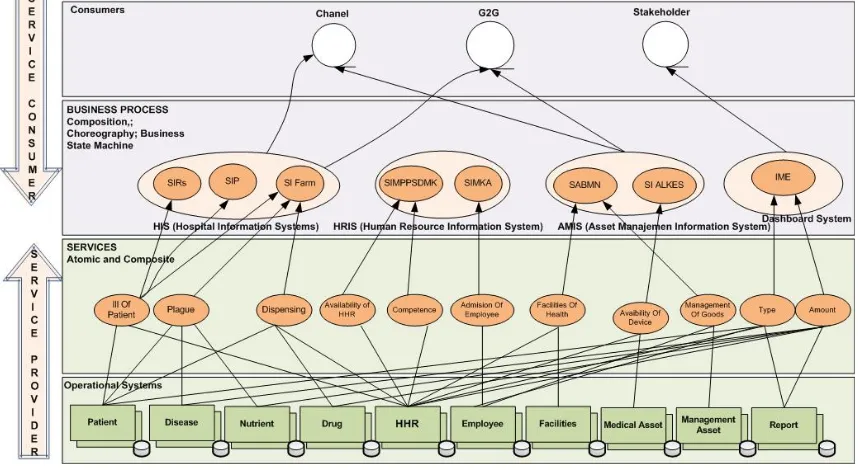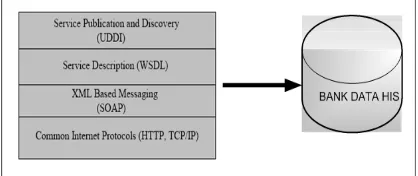Model of Human Resources for Health Information
Abstract—One of the crucial aspects of health development is human resources due to its role in both management and implementation of the health care system. The implication of this situation is the need for proper information and data collection. Human Resources for Health Information System (HRHIS) works as a tool in collecting such information. The fragmented business process posed a substantial challenge towards any effort in integrating HRHIS with Health Information System (HIS) Data Bank. However, through the simultaneous utilization of Service Oriented Architecture (SOA) method for model integration, Health Level Seven (HL 7) for standard data exchange, and Extensible Markup Language (XML) for standard data formatting, this study managed to construct a system model that integrated HRHIS with HIS Data Bank. The model was created subsequently enable the accuracy of HRHIS information.
Keywords— Health Information System, HIS, SOA, HL 7
I. INTRODUCTION
The current national health system development emphasizes empowerment and development of human resources for health (HRH), making HRH one of the top priorities in national health system planning [1]. One of the essential aspects of this developmental effort is improving the accuracy of data collection, thereby enhancing information quality. Human Resources for Health Information System (HRHIS) is an application created to meet these needs. It can be applied to all levels, ranging from national to provincial and all the way to district/city level.
The government’s recognition of the importance of health led to the establishment of the National Development and Empowerment of Human Resources for Health, whose a major role involves the management of HRH. This institution ensures availability and distribution of HRH, which includes: (1) planning important human resource requirements; (2) procuring health education and HRH training; (3) utilizing HRH to increase welfare distribution; and (4) implementing quality control on HRH.
Development and Empowerment of Human Resources Health Management Information System (DEHRH-MIS) is a sub-system built to map health data resources throughout Indonesia and is used at the provincial and district/city levels. The process includes data system design, supply, training, education, distribution, and supervision. To support its
implementation, the Indonesian Ministry of Health is currently devising a road map for Health Information System (HIS), which integration with existing sub-systems leads to the creation of a National Health Data Bank. The aim is to concatenate all databases into a single entity, rendering the existence of uniform data from all provinces, districts, and cities. However, the data processing is still fragmented; mainly due to the fact that each work is done in geographic isolation from one another. Consequently, this calls for system improvement and integration as well as accuracy in data and information from all geographical levels, with regards to even the HIS Data Bank.
The main problem then becomes finding an effective method for integrating all of the aforementioned systems. This calls for a proper model that considers the standards of data exchange and has flexible formats with uncomplicated data transfers (allowing for cross-usage by various operating systems).
A. Current Conditions
The County Municipal Government has a sub-system that is employing a technical implementation unit (UPT) and other health care facilities. This includes both the online and offline application of DEHRH-MIS, through which the district/city can rapidly access and perform a real-time updates of information through document description and data aggregation.
The Provincial Government has a technical unit in charge zone area (UPTD), central technical implementation unit (UPT) and the private sector where the province could see or open the application subsystem underneath so that the provincial government can print the document description and aggregate the data required for the planning and procurement of materials analysis territory.
DEHRH-MIS to monitor specific data resources, both human health and the aggregate description documents. These become a basis for planning and policy analysis to determine the direction for human resource policies on national health. The Ministry of Health through the Center for Data and Information is responsible for the national health data providing the description and aggregate output documents to the Agency for Development and Empowerment of Health Human Resources in charge of human resource for health data periodically.
The systems mentioned above are still fragmented for the most part. A change in data submission and processing would result in integration with the HIS, forming a model of the national health data bank.
II. METHOD
This study used the method of Service Oriented Architecture (SOA) as its integration model [2]. The data exchange protocol was in accordance with the American National Standards Institute (ANSI); that is, Health Level Seven (HL7) [3], which is commonly used for health information [4]. The extensible markup language (XML) was utilized for the data transfer format [5].
III. RESULTS
A. Service Oriented Architecture (SOA) Integration
Fig. 1. SOA Layer – Phase One
Service Oriented Architecture (SOA) is a service-oriented architecture that splits problems into smaller but co-synergistic services [6]. SOA reviews an application through its technology, data, environment of the implementation sides, as well as through available services. In short, it is an architecture of system that combines several parts of an application, or a software, into a service package. This results in an integrated interaction of the components. Among the advantages of using the SOA architecture are flexibility, scalability, replaceability, and tolerability of fault [7].
The most suitable integrated model for this research consists of 4 main components: process, operation, message, and service [8] with interconnectivity among them. In relation to SOA layering, the commonly used application of an organization is the enterprise architecture.
SOA utilizes service packs throughout its life cycle by defining and determining the information technology architecture, hence supporting the various applications for data
exchange. These functions are independent from operating systems and programming languages underlying these applications. The integration using web services going through four stages or phases are detailed as follows:
1) Phase One
Each system runs on its own and is still fragmented at this stage. This condition requires an operational mapping system, as shown in Figure 1.
2) Phase Two
Figure 2 illustrates the creation of an integrated database with the following categories: Patient, Disease, Nutrition, Medication/Drugs, HRH, Employee/Staffing, Health care Services/Facilities, Medical Equipment/Devices, Asset Management, and Report. This initiates the parsing of data to allow for visibility that would ease integration. These data can communicate at all levels with the services and are working according to SOA requirements.
Fig. 2. SOA Layer – Phase Two
3) Phase Three
At this stage of the SOA was already evident from the phase of unity, the second and third phase forming an integrated business process is not fragmented for all information and applications such as: SIRS is the hospital information system, SIP is the clinical information system,
SI FARM is the pharmacy information system, SIMPPSDMK is the human resource for health information system, SABMN is the state property information system, SI ALKES is the medical devices information system, and IME reports the management information system. These layers are shown in Figure 3.
Fig. 3. SOA Layer – Phase Three
4) Phase Four
In this phase, the final model to meet the target of a fully integrated systems architecture has been achieved. For each
external stakeholders, government to government, and the general public have been connected and communicated.
Figure 4 illustrates the integration of these systems.
Fig. 4. SOA Layer – Phase Four
B. SOA Model in HIS
The main components of developing the Data Bank is the architecture of the HIS web service. The HIS Data Bank contains a service provider called service request that contains running applications in each division, with all different platforms of programming languages. All request and delivery transactions that use the web service are recorded and stored
in the registry. On the other hand, the Simple Object Access Protocol (SOAP) is a set of rules to facilitate the Extensible Markup Language (XML) to exchange data that have been standardized by the Health Level 7 (HL7), which is then standardized by the Web Service Definition Language (WSDL). The resulting XML document is then stored into the registry. The schematic is shown in Figure 5.
Fig. 5. SOA Model in HIS
C. SOA Security in HIS
The following Secure Socket Layer used in SOA HIS is an encrypted model in which the 64-bit version is used. The process is done by covering all requested package in a form of random coding, as much as 64 bits, guaranteeing data security. The data is transferred to the web service destination without any interference from outside. As shown in Figure 6, the user (an operator, administrator to the person in charge, and other related stakeholders) is the one with access to the web interface (applications such as the HIS).
Fig. 6. HIS Security in HIS
Web Interface
SSL
User HIS
Bank
Web Service Library SSL
D. Data Bank Design of HIS
The data then are encrypted to the web service that contains web service HL 7 and XML and will be transferred to the HIS Data Bank as illustrated in Figure 7.
Fig. 7. Data Bank Design of HIS
E. Health Level 7
Supporting the method model of the aforementioned SOA integration requires a standardized integration of medical information from various sources, e.g. hospital, health organizations, and other medical community, which are then pooled into the Data Bank called the Health Level Seven, or HL 7 [9]. HL7 is one of the standards from American National Standards Institute (ANSI) that is accredited by the Standards Developing Organizations (SDO) for use within healthcare system [3].
F. How to Create Messages in HL 7
Standard information included for medical data exchange consists of number of patients, types of diseases, and prescriptions. However, they also tend to include data of human resources for health, such as physicians and other medical staff members [10]. Below is the standard Message of data exchange in HIS Data Bank by using HL 7:
●
Segment is the title●
Field (data element) is field name●
Component>> Sub component name sub component >> Sub-sub component name sub-sub
component
G. HL 7 in HIS Model
As previously mentioned, the standard HL 7 exchanges ensure that each request, made by the provider for entry into the Data Bank, must be done through some messages. Figure 8 depicts the HIS process description.
Fig. 8. HL 7 in HIS
H. XML
XML (eXtensible Markup Language) refers to the mark-up language for describing data and is a subset or brief version of SGML (Standard Generalized Markup Language). Worldwide Web Consortium (W3C) is an international body that started the XML standardization mid-1996 and re-released XML 1.0 in 1998.
XML was initially inspired by the Standard Generalized Markup Language (SGML) but simpler and easier to understand [11]. Thus, XML was rapidly adopted as the standard for data exchange, especially for the interuse of applications and platforms. The credit point of the XML is its extensible and independent platform. Unlike HTML, XML does not have standardized tagging. With XML, creating tags becomes a more independent and individualized process, allowing for customization to an application.
XML also simplifies data sharing, storing data in a simple plain format. As a result, data can be used in any computer, with any application without resulting in data loss during a change in operation system or application. If supported by the applications developers, any type of word processor, spreadsheet, database, and other data can be stored in XML format, enabling inter-applications data exchange without precedence of data conversion.
I. XML in HIS
The XML language is a software system designed to support interaction and interoperability from one machine to another within a network. The web service has an interface form that can be processed by the WSDL (Web Service Description Language) machine while other systems can interact with the web service by using SOAP messages (HTTP-XML and Web-related standard W3C). Accordingly, the interface can be registered by using UDDI (Universal Description, Discovery, and Integration). HIS web service provides mechanisms for addressing instructions from documents, messages, as well as intermediate check points. All these mechanisms enable standardization of structures of process policies within SOA, as shown in Figure 9.
J. XML Exchange Format
After using SOA and HL 7 to integrate the model, there needs to be a format for data delivery. This can be defined by using the Extensible Markup Language (XML) because the data can be implemented in various platform operating systems independently [11].
XML provides the way to describe data structure. Unlike tagging in HTML that functions as the control of data and the display, XML labels are used to define the structure and type of data itself [12]. Below is the general standard of XML:
<heading>
Heading functions to define versions, entity, encoding type, and DOCTYPE.
•<root>: Root acts as the parent of other
elements. All XML documents must a root for its element; this can also function as the package title of sent data.
•<child>: Child element functions to store all the
sent data.
•<subchild>
:
Subchild element is the offspring of the child element, where the content of the sent data have its data submerged.
IV. DISCUSSION
In integrating HRHIS and HIS, the biggest challenge in implementing SOA as an integrated model, HL 7 as the data exchange standards, and XML for the data exchange delivery comes from the attempt in a paradigm change. Nevertheless, this needs to be done to enable data integration in the business process within health organizations and to change the culture of data sharing [13]. Moreover, the security must also be fully considered, as the SOA uses web service technology, especially when supporting business transactions through the Internet (global). This calls attention to the vulnerability of using web service, despite the current existence of security standards for web service applications [14].
V. CONCLUSION
The Development and Empowerment of Human Resources Health Information System (HRHIS) model can be implemented as an integrated health information system with data throughout the Ministry of Health, especially the human resource for health data. With Service Oriented Architecture (SOA) as a model of integration, the Health Level Seven (HL 7) as the data exchange standards, and eXtensible Markup
Language (XML) as a data delivery format, the current design needs to gather accurate data can be met.
From the technical side, the appropriate technology and exchange standards are needed for each data type, allowing for all sub-systems involved to communicate with the HIS data bank. Cloud computing technology in data storage should be considered since every year the amount of data in health human resources increases in amount, putting pressure on the need for large data storage.
REFERENCES
[1] Badan Pengembangan dan Pemberdayaan SDM Kesehatan, Rencana aksi penguatan sistem informasi sumber daya manusia kesehatan tahun
2011-2014. Jakarta: BPPSDMK, 2010.
[2] Firat K., L. E. Moser, P. Michael and S. Melliar, Building a Distributed E-Healthcare System Using SOA. Los Alamitos, CA: IT Pro, 2008, pp. 25-26.
[3] Health Level Seven International. (2012, June). Health Level Seven. Available: http://www.hl7.org.
[4] Sarbadhikari, N. S, “The State of Medical Informatics in India: A Roadmap for Optimal Organization,” Journal of Medical Systems, vol. 29, pp. 127, Jul. 2005.
[5] Rau, H.-H., C.-Y. Hsu, Y.-L. Lee, W. Chen and W.-S. Jian, Developing Electronic Health Records in Taiwan. Los Alamitos, CA: IT Pro, 2010, pp. 25-26.
[6] Papazoglou, M.P. and D. Georgakopoulos, “Service Oriented Computing: Introduction,” Communications of the ACM, vol. 46, pp. 25-28, 2003.
[7] Newcomer, E. and G. Lomow, Understanding SOA with Web Services. Boston: Addison Wesley Professional, 2004.
[8] Da Silveira, M. and N. Guelfi, “Exploiting Service Oriented Architectures for the Design of E-Health Systems,” presented at International Conference on Health Informatics, Madeira, Jan. 28–31, 2008.
[9] Eggebraaten, T.J., J.W. Tenner and J.C. Dubbels, “A Healthcare Data Model Based on the HL7 Reference Information Model,” IBM Systems Journal, vol. 46, pp. 5-17, 2007.
[10] Zhang, L. and X. Xu, “A Community Public Health System Design Based on HL7 Criterions,” Computer and Information Science, vol. 4, pp. 148-151, 2011.
[11] Brown, A. W., M. Delbaere, P. Eeles, S. Johnston and R. Weaver, “Realizing Service-Oriented Solutions with the IBM Rational Software Development Platform,” IBM Systems Journal, vol. 44, pp. 727-752, 2005.
[12] Microsoft Corp. (2012, Oct). XML Integration of Relational Data. Available: http://msdn2.microsoft.com/en-us/library/aa258806(SQL.80).aspx.
[13] Marks, E. A. and M. Bell, Service-Oriented Architecture: a Planning and Implementation Guide for Business and Technology. Hoboken, NJ: John Wiley & Sons, 2006.
[14] Hondo, M., N. Nagaratnam and A. Nadalin, “Securing Web Service,” IBM Systems Journal, vol. 41, pp. 228-241, 2002.



